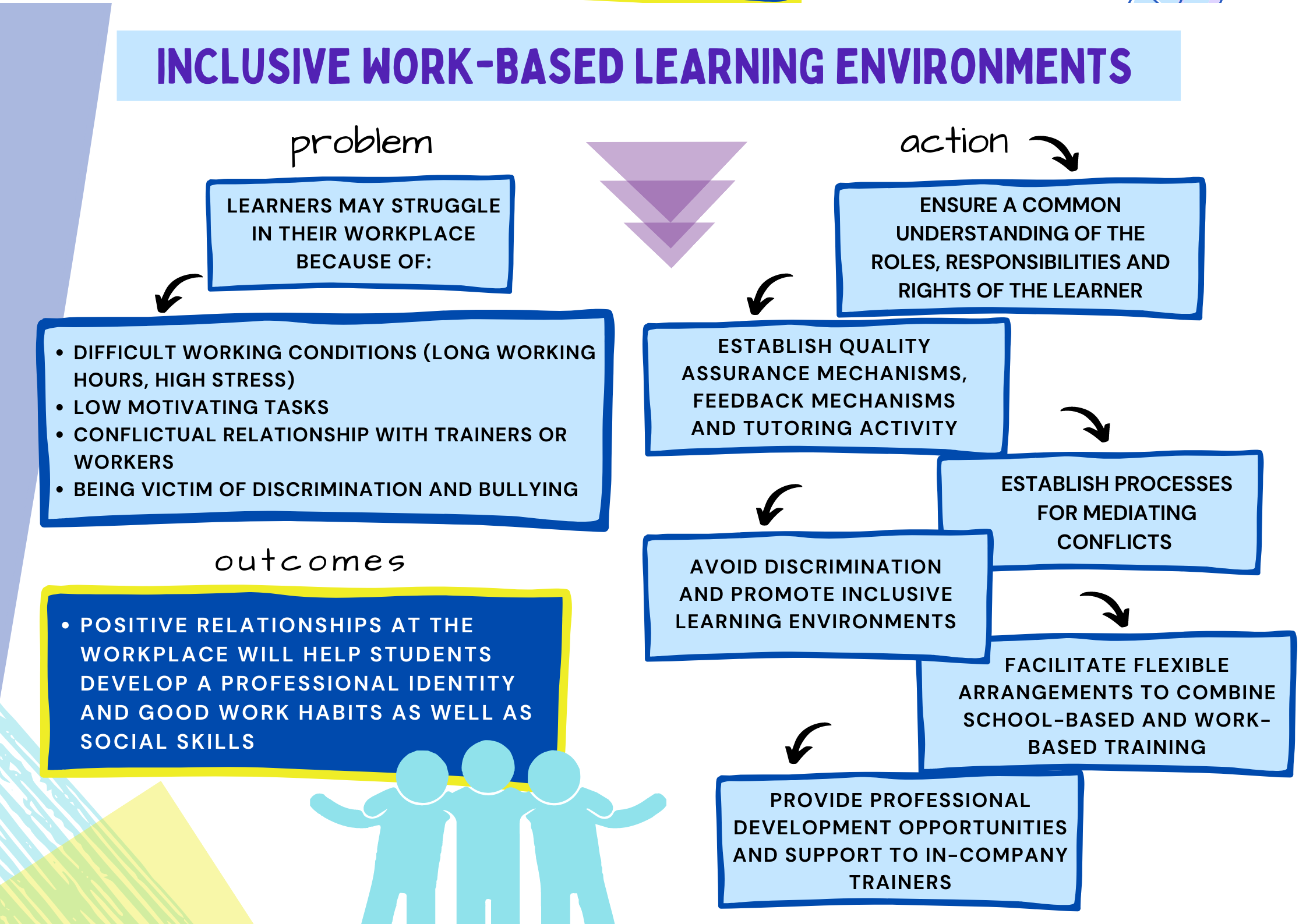Problem statement
Addressed problem: Finding a welcoming work environment
For many young people, an apprenticeship or work-based training as part of a vocational programme, is their first experience in the world of work. Finding a welcoming and supportive work environment, where there are good learning opportunities, can be very motivating and contribute to attaining a qualification.
However, work-based training can also be discouraging and lead to drop-out. This may be due to a mismatch between the learners’ expectations and the reality of the profession, or to a lack of work readiness. For instance, some learners struggle to cope with tough working conditions such as long working hours, having to work on weekends, hard manual labour, or high levels of pressure and stress. Others are disappointed to have to do less motivating tasks (e.g. cleaning) in the beginning of their placement.
It can also be due to the low quality of the work-based placement and even an abuse of the situation of trainees by employers. Conflictual relationships at the workplace either with trainers, other students, or other workers can also lead to demotivation and drop-out. In some cases, learners can be the victims of discrimination and bullying.

Beneficiaries
All apprentices and other vocational education and training students participating in work-based training.
Addressing the problem
What makes a work-based learning environment inclusive and supportive?
The following tips are given as advice to policy-makers and practitioners involved in the design and delivery of vocational programmes. The information is based on Cedefop research into successful measures.
Learners’ roles, responsibilities and rights should be clear for the company and the learner (and his/her family in the case of minors). There can be a written agreement between the training provider, the company and the learner specifying the training programme, the activities and the working conditions (including working hours). Also, there is the possibility of using a code of conduct or similar document.
There should be mechanisms in place to ensure that employers comply with their duties in relation to training. The type of mechanisms can vary significantly across countries and type of training scheme. While in some cases there could be an external agency in charge of quality assurance, in others trade unions might be involved in such quality checks. Also, training providers can have an important role in monitoring the development of the in-company training of their students.
Such mechanisms should also detect if the in-company trainer(s) need additional training or support to be able to adequately perform their role.
When the programme combines school-based and work-based learning, there is often a tutor or supervisor at the VET school. This professional can:
- be in charge of periodic discussions with the learner to assess the development of the work-based training,
- accompany the learner to the workplace on the first day, and/or
- visit the learner at the work place on a periodic basis.
There should also be a tutor or person responsible for each trainee at the workplace. This professional should also engage in discussions with the learner about the development of the apprenticeship or traineeship. There can also be a mentor or coach independent of the learning provider or the company.
As part of the feedback processes, learners can refer to conflicts with the in-company trainer. It is important that there is an impartial mediator to help solve such conflicts. This person can be the tutor or supervisor at the training provider, or a coach or mentor independent of the training provider or the company.
Even under tough work conditions, learners can succeed in finalising their training programme if they develop a sense of professional identity. This requires an engaging and motivating process which enables young people to perceive the training as meaningful. Work-based learning offers a good context for the development of a professional identity through the authentic interaction between the young person, his/her co-workers, as well as the trainer and the company leadership. Trainers who express that they are proud of their profession act as role models. Through ‘role models’ young people gain an idea of the profession and incorporate its culture.
Knowing how to practise a profession is not a synonym of knowing how to teach it. Also, employers are often not used to working with young people and they expect them to behave like adults and workers from day one.
Trainers at the workplace should receive some training and support to help them:
- manage their expectations about learners’ performance
- adapt the training to the skills and knowledge of learners
- support learners facing disadvantages (e.g. physical handicaps, disadvantaged socio-economic backgrounds)
- identify distress signals from learners and support, in a timely manner, apprentices or trainees at risk of dropping out
- manage conflicts and deal with situations of discrimination and bullying at the workplace
Discrimination should be avoided at entry and during the development of work-based learning. At entry, the standardisation of application procedures for apprentices / trainees, in particular in small and medium size firms, helps prevent discrimination against minority groups.
During the development of the work-based learning the tutor or supervisor at the company, and at the training provider, need to be alert to detect any discrimination or bullying situations as early as possible and act against these. People with physical handicaps should be given the opportunity to develop their work-based training in a fully accessible workplace.
Making learning environments more inclusive also implies using learner-centred pedagogies to adequately respond to the needs of the diverse learner population.
In cases where learners combine school-based and work-based training, there is a need for flexible arrangements. Training providers may need to adapt the training hours to the business working hours. For instance, if a business undertakes most of the work in the morning, the training provider can move its training hours to the afternoon, or organise the training on alternate days (e.g. two days a week at the training provider and three at the company).
Another aspect that needs to be taken into account is the transport of learners to the company. It is possible that there is no public transport and learners do not have their own means to travel there. Training providers or companies can establish agreements with other entities, including local authorities to facilitate learners’ transportation.
Expected outcomes
Positive relationships at the workplace help develop a professional identity and promote good work habits and social skills. When learners’ achievements are recognised and valued by colleagues, this contributes to an increase in self-esteem and self-confidence.
The following outcomes can be expected at different levels:
| INDIVIDUAL | INSTITUTIONAL | SYSTEM |
|---|---|---|
|
|
|





